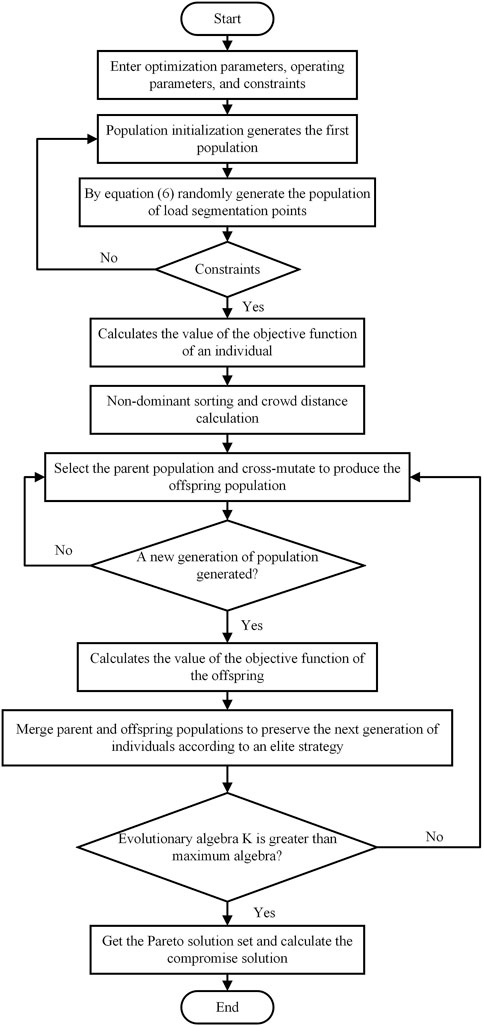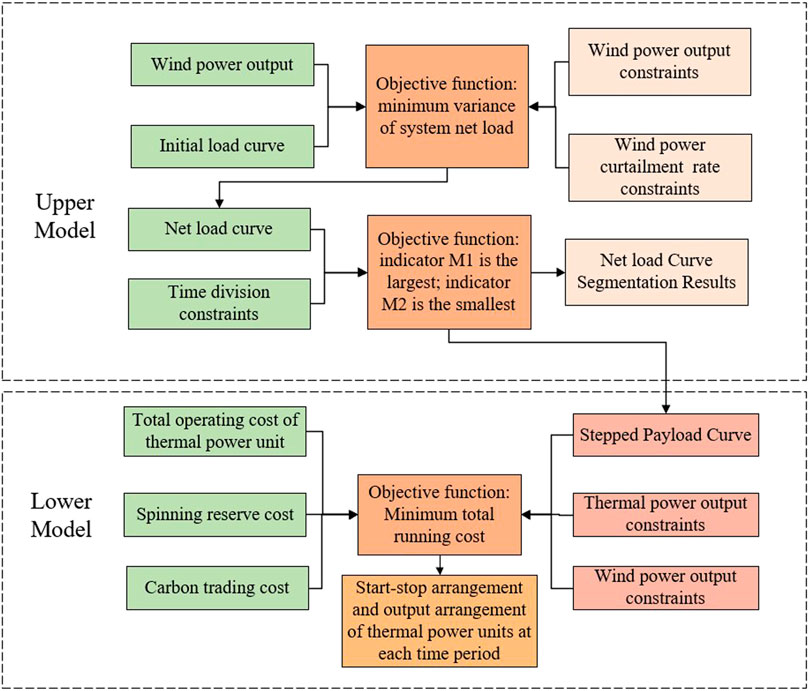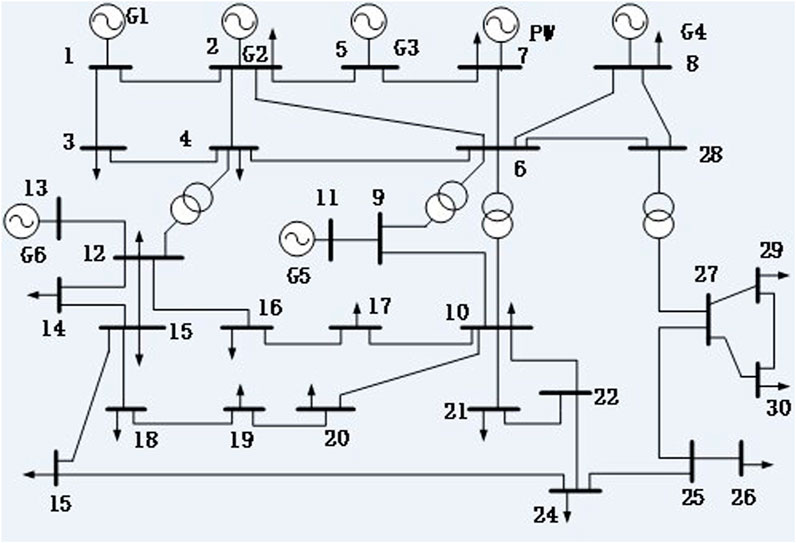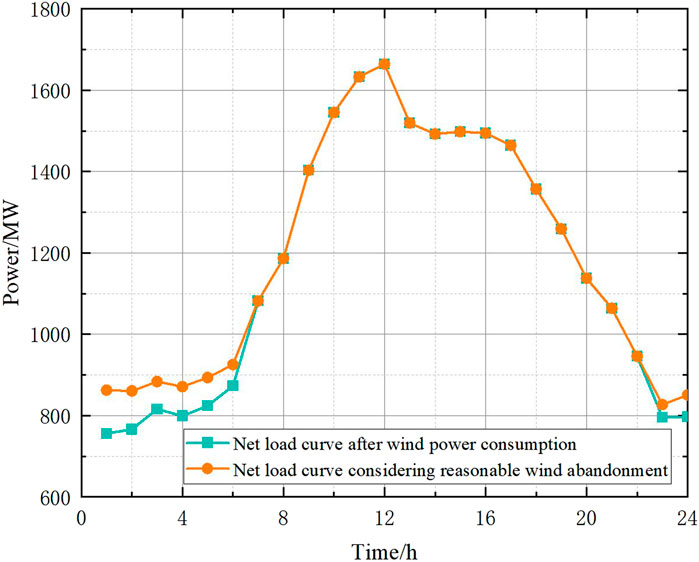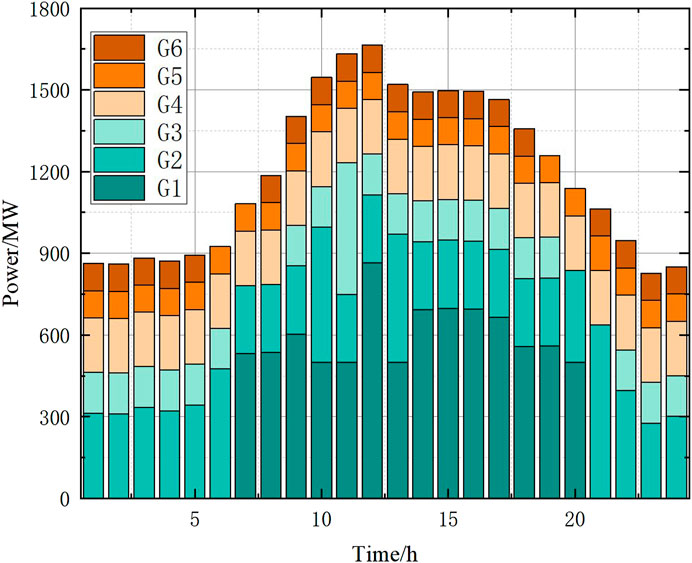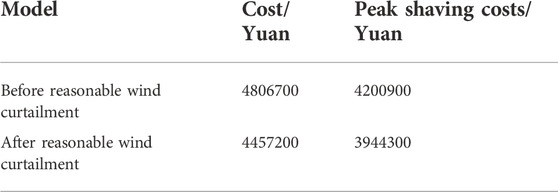- Electrical Engineering and Its Automation, Xi’an University of Technology, Xi’an, China
In view of the large output of wind power during the load trough time, the peak regulation cost may increase sharply, and the traditional hourly dispatch may not be able to accurately track the load fluctuation due to the fluctuation of renewable energy. In this paper, based on different time granularities, an adaptive segmented double-layer economic scheduling model of the net load curve considering reasonable wind abandonment is constructed. The model can better cope with net load changes while reducing the load peak-to-valley difference. First, a reasonable wind abandonment model is established under different time granularities of 5 min, 15 min, 30 min, and 1 h; Then, based on the static thinking of the net load curve by time period, the load change in the hourly scale is fully considered without changing the total number of dispatching periods so that each dispatching period can adaptively select the duration according to the change of net load gradient, and a self-adaptive subsection model of the net load curve is established to minimize the total running cost. Finally, taking IEEE-30 nodes as the example system, the NSGA-II algorithm and CPLEX solver are used to solve the model. The results verify the economy and feasibility of the proposed model.
1 Introduction
As wind power, photovoltaic, and other new energy sources are greatly affected by the natural environment and have obvious randomness and volatility (Liu Y et al., 2021; Hao C A et al., 2021; Guo T et al., 2020), full consumption of wind power may cause a peak-to-valley difference, deep peak regulation, and sharp increase in peak regulation cost (Ming D A et al., 2021; Liu et al., 2022; Wei H et al., 2022; Wang J et al., 2021; Chen et al., 2021) and even cause a potential operation risk of the power grid (Zhou Y et al., 2021; Dall’Anese et al., 2018; Cheng et al., 2019; Deng et al., 2019; Luo et al., 2019). Therefore, when the wind power output is large and the load is low, selectively discarding part of the wind power output can not only reduce the operation risk of the power grid but also help to improve the flexibility of power grid dispatching and the overall economic benefits.
At present, based on the reality that appropriate wind abandonment can improve the economic benefits of the system, there are many studies that consider abandonment of wind power (Yang et al., 2020; Chen et al., 2020; Gan et al., 2022; Wang et al., 2022). Wanla et al. (2021) constructed the steady-state power flow of the integrated energy system through the coupling of power grid and heat network and constructs the collaborative optimization operation model of “source-grid-load-storage” of the integrated energy system with the goal of system economic operation to solve the curtailment air volume. Sun.et al. (2020) proposed an optimization method for the wind farm access capacity and access location considering the minimum wind curtailment and combines the minimum wind curtailment index and the highest reliability level index to optimize the wind power access capacity. Zang.et al. (2022) established the optimal energy abandonment constraint model, considering the characteristics of wind and solar reverse peak regulation, to improve the economy of wind and solar absorption of the system and the low carbon of thermal power peak shaving , and the net load curve is “peak shaving and valley filling.” The aforementioned literature proposes to realize the optimal operation of the system by abandoning part of the wind power and solves the problem of curtailed wind power, but fails to consider the change of curtailment volume over a timescale.
For dealing with the uncertainty of wind power, traditional hourly dispatch cannot flexibly deal with the fluctuations in the net load data. For this reason, most literatures coordinate day-ahead, intraday, and real-time dispatching (Dou.et al., 2019; Liu.et al., 2022), and coordination of multiple timescales is used to gradually reduce the impact of errors in an operation (Shi et al., 2019; Yang et al., 2021; Tang et al., 2022). Although this method can effectively reduce the deviation, the model usually participates in the day-ahead scheduling operation with an hour-level time resolution, ignoring the error caused by the approximate distribution of discrete time (Song.et al., 2021; Mz et al., 2021; Song.et al., 2021). The discrete time at the hour level cannot reflect the details of the gradient change of the net load, and the wind power may change greatly within the hour. Therefore, the traditional hour-level model cannot meet the demand for flexibility, and it is necessary to optimize the time interval more flexibly to better response to the changes in the net load.
Ran et al. (2020), according to the slow dynamic characteristics of cold and thermal energy, adopted the daily mixed timescale correction method of electric cooling thermal coupling, optimizes the output of cold and thermal energy-related equipment at the upper layer with a low time resolution, and adjusts the power storage device and tie line scheduling plan at the lower layer with a fine temporal resolution and the correction results of the upper layer, to build a mixed timescale economic scheduling model considering the difference of energy characteristics. Although this method improves the flexibility of the system, it also increases the computational complexity. Gan.et al. (2020), to solve quickly, proposed a renewable energy generation and demand load forecasting model with a coarse-grained resolution of 15 min or 1 hour using a single temporal resolution. It can be seen that while using fine temporal resolution saves operating costs, increasing the time interval leads to an exponential increase in the solution time. The model using hourly summarization, while reducing the computational complexity, does not accurately track changes in the net load.
In view of the aforementioned problems, first, reasonable wind curtailment models are established at different time granularities (Li.et al., 2022; Liu.et al., 2019), and its impact on the fluctuation of the net load curve and peak regulation cost is analyzed. Second, to accurately track the net load change, a segmentation model of the net load curve with an adaptive selection of scheduling duration is established. Finally, the impact of reasonable wind curtailment and adaptive segmentation of the load curve on power grid peak regulation and overall economy is comprehensively analyzed.
2 Reasonable wind abandonment models under different time granularities
Due to the anti-peak regulation characteristics of wind power, a few peak wind power output occurs in the low load period, to absorb more peak wind power output should reduce the system’s thermal power output, but at the same time lead to an increase in the cost of rotating backup, this will result in a sharp increase in the total operating costs of the system. In this regard, under different time granularities of 5 min, 15 min, 30 min, and 1 h, the optimization goal is to minimize the net load variance of the system, consider the constraints of wind power output and wind curtailment, establish an optimization model, and use the Cplex solver to solve it.
2.1 Objective function
Due to the uncertainty of load and wind power output, the peak-to-valley difference of the system power load is large, and the model ensures that the net load variance gradually decreases at the expense of discarding an appropriate amount of wind power generation, so that the net load curve is smoother (Zang.et al., 2022). The objective function is the minimum variance of the net load of the system, and its expression is given as follows:
where
2.2 Constraint condition
The solution of the reasonable wind abandonment optimization model should satisfy the following constraints:
1) Wind power output constraints:
where
2) Abandon wind rate constraint:
To avoid a large amount of abandonment of wind farms due to the smoothing of the net load curve, the maximum allowable abandonment rate constraint is added to this paper, namely,
where
3 Net load curve self-adaptation segment optimization model
Based on the abovementioned model, under the different time granularities, based on the idea of load curve segmenting into time-segment statics, the continuous typical daily load curve can be reasonably segmented, which will effectively respond to the change of net load curve, it has better rationality and economy. In theory, the more time segments are divided, the more accurate the tracking of load changes can be but to avoid the equipment action is too frequent, the impact of equipment life and economy, so the number of segments is still the original scheduling time, that is, 24 time slots. Figure 1 shows the calculation process of the adaptive segmentation optimization model for the NSGA-II algorithm to solve the net load curve.
3.1 Objective function
The multi-objective optimization method is used to segment the net load curve, wherein the optimization objective is that the index representing the dispersion between the average values of the net loads in different periods is the largest, and the index representing the dispersion of the net loads in the same period is the smallest. If the number of segments of the net load curve is, to make the direction of the optimization target consistent, the optimization target is treated as the reciprocal, that is, the objective of the optimization segment of the net load curve is
where
3.2 Constraint condition
The net load value of each time in each subsection after the optimization subsection takes the average load value of that subsection. When the net load curve is divided into
3.3 Model solving process
This paper is solved by the NSGA-II algorithm (Verma et al., 2021), which is usually used in the field of multi-objective optimization, which has high computational efficiency and good robustness, and the obtained pareto solution set is evenly distributed, as shown in Figure 1.
4 Considering reasonable abandon the wind net load curve adaptive piecewise double-layer optimization scheduling model
In this paper, under different time granularities, based on the optimal abandon of the wind rate of each time period, the load curve is divided reasonably to flexibly respond to load changes, and finally the start–stop and output arrangements of thermal power units are solved with the goal of minimizing the total operating cost. Therefore, a load curve adaptive subsection double optimal dispatch model considering reasonable wind abandon is constructed, and the structure diagram is shown in Figure 2.
1) The upper-layer optimization model is 5 min, 15 min, 30 min, and 1H at different time particles, with the minimum difference between the net load variance of the end power grid as the target function to optimize the wind abandonment rate in each period of time. Therefore, the optimal grid-connected power of wind power at different time granularities is obtained. At the same time, on the basis of satisfying the constraints of control variables, the net load curve after wind power grid-connected is used to solve the objective function by using NSGA-II, and the time segment points are used to obtain the step net load curve.
2) The lower-level optimization model optimizes the output of thermal power units in each period based on the stepped net load curve transmitted by the upper-level model, with the goal of minimizing the total operating cost. A number of costs are considered in the objective function, including the cost of peak shaving of thermal power units, wind power, system spinning reserve costs, and carbon transaction costs. The solver is used to obtain the optimal output, start–stop arrangement and minimum operating cost of thermal power units in the receiving end grid.
4.1 Lower-layer optimization scheduling model objective function
Many costs are considered in the objective function, including the peak load regulation cost of thermal power units, system rotation standby cost, and carbon transaction cost.
where
1) Peak shaving cost
In the basic peak shaving stage, the peak shaving cost of the thermal power unit mainly comes from the fuel cost and the startup and shutdown costs. The calculation expression is as follows:
where
Linearize the coal consumption function piecewise and divide it into m segments, replacing Eq. 10 with the following equation:
where
According to the output state of the unit, the peak shaving stage of the thermal power unit can usually be divided into basic peak shaving and deep peak shaving stage, and deep peak shaving can be divided into oil-feeding depth peak-shaving and non-oil-feeding depth peak shaving stage according to the peak shaving depth and combustion medium, as shown in Figure 3. Among them,
When the unit operates at the non-oil-feeding depth peak shaving stage, the rotor metal will produce certain additional loss due to the influence of alternating stress, which will reduce the service life of the unit. The life loss cost generated during the depth of the unit peaks
where
During the oil-feeding depth peak shaving stage, the peak adjustment costs of the thermal power unit except for fuel costs, start–stop costs, and life loss costs, the cost
where
To sum up, the peaking cost of thermal power units can be expressed as the following piecewise function:
2) System spinning reserve cost
where
3) Carbon trading cost
The carbon trading mechanism restricts greenhouse gas emissions through market-based trading of carbon emission rights, which is one of the effective measures to achieve the “dual carbon” goal. At present, carbon emission trading is mainly divided into project-based trading and allowance-based trading. The project-based trading mainly refers to carrying out green development projects to achieve carbon emission reduction; quota-based carbon trading refers to the allocation of carbon emission quotas by relevant government departments to carbon emission sources. When the actual carbon emission of the emission source is higher than the allocation quota, the carbon transaction is positive, that is, the carbon emission source needs to pay a high fine to purchase carbon emission rights; and when the actual carbon emission of the emission source is lower than the allocated quota, the carbon transaction is negative; that is, carbon emission sources can sell carbon emission rights.
It can be seen from Figure 4 that the thermal power units need to purchase carbon emission allowances under the carbon trading mechanism, which will increase their operating costs and achieve the purpose of reducing carbon emissions. The sale of carbon trading quotas in the operation of wind farms will generate certain income in the grid connection, increase its grid-connected consumption, and promote the development of wind power industry. Therefore, with the improvement of the carbon trading mechanism, it can effectively promote the development of new energy power generation while reducing the carbon emissions of the power industry and promoting the development of a low-carbon economy. That is, the carbon transaction cost is calculated as follows:
where
1) Carbon transaction cost of thermal power unit
Thermal power units will generate a large amount of carbon dioxide during operation. After taking into account the carbon transaction cost, the excess carbon emission quota needs to be purchased in the form of transactions, which will increase the operating cost of thermal power units, which is called the carbon transaction cost of thermal power units. The calculation formula is given as follows:
where σ is the carbon transaction price of the thermal crew at the moment of t, yuan/t;
The carbon emissions of thermal power units are mainly related to their output. However, due to the randomness of wind power, when the wind power is connected to the grid, to ensure the safe operation of the power grid, it is necessary to increase the rotating reserve capacity of thermal power units, which increases the carbon emissions from thermal power units. Therefore, the formula for calculating carbon emissions
where
The carbon emission quota is determined according to the dispatching output of the generating unit. The calculation formula of the carbon emission quota
where
1) Carbon transaction cost of wind farm
Wind power is a clean new energy power generation. Carbon emissions are not generated during the operation, but wind power has strong uncertainty. It will increase the rotating backup capacity of the system during the grid. The cost of increasing the mass is defined as the carbon transaction cost of wind power. The calculation formula is given as follows:
where
4.2 Lower-layer optimization scheduling model constraint conditions
1) Equality constraints
The system power balance constraints:
2) Inequality constraints
1) Hot standby:
where
2) Unit force constraint:
where
3) Crew climbing constraints:
where
4) Unit start and stop time constraints:
where
5) Start–stop cost constraints:
where
6) Power flow security constraints:
where
7) Positive and negative spinning reserve constraints:
where
5 Case analysis
5.1 Example system description
In this paper, an improved IEEE -30 node system is used to simulate the power grid. The system consists of six thermal power units and one wind farm. The structure of the system is shown in Figure 5. According to the change of the typical daily load curve and wind farm law, combined with the load of the original system and the scale of wind farm, the typical daily load curve and wind power output curve of the system are simulated, as shown in Figure 6.
Parameter settings of the upper model: the rated capacity of the wind farm is 800MW, and the maximum wind abandonment rate
The main parameters of the lower-level optimization model are shown in Table 1, and the parameters of the thermal power units are shown in Table 2.
5.2 Analysis before and after reasonable wind abandon
The CPLEX solver is used to solve the reasonable wind abandonment model, and the optimal wind abandonment rate at different time granularities is obtained, as shown in Figure 7. The wind power output before and after wind curtailment is shown in Figure 8, and the net load curve before and after wind curtailment is shown in Figure 9. The startup and shutdown statuses of six thermal power units are shown in Figure 10 indicates shutdown and one indicates startup. The output arrangement of the thermal power unit is shown in Figure 11.
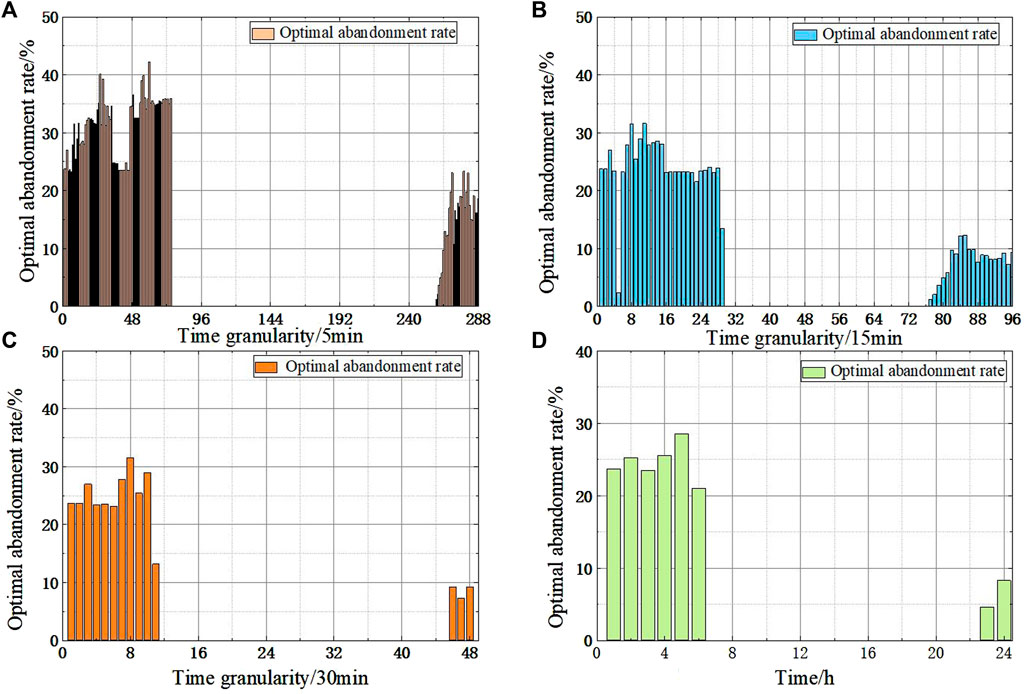
FIGURE 7. Optimal wind curtailment rate at different time granularities. (A) Curtailment rate at 5 min time granularity; (B) Curtailment rate at 15 min time granularity; (C) Curtailment rate at 30 min time granularity; (D) Curtailment rate at 1 h time granularity.
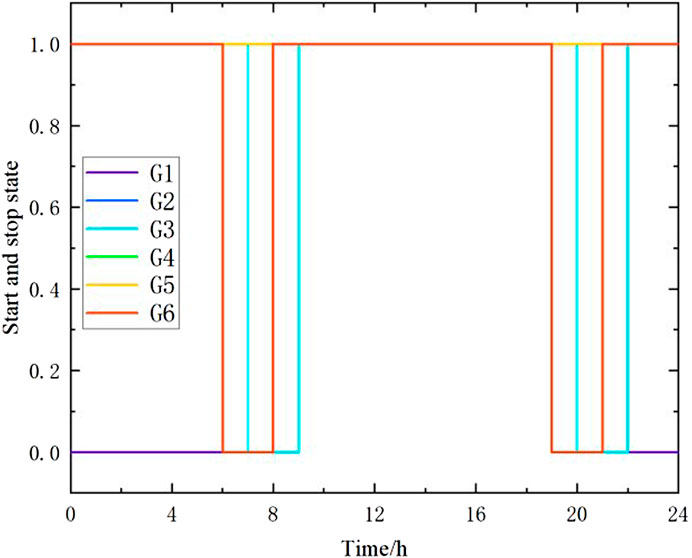
FIGURE 10. Startup and stop states of thermal power unit after reasonable abandoned wind curtailment.
It can be seen from Figure 7 that under different time granularities, the wind abandonment mainly occurs in the period 0:00–6:00 and 23:00–24:00. During this period, the load is relatively small, and the wind curtailment rate is maintained at a high value. The maximum wind curtailment rate reaches 28.5%, and the optimal wind curtailment rate in other periods is 0. This is related to the inverse peak regulation characteristics of the wind power and the objective function of the model. At the cost of curtailment of more wind power generation, the net load variance is guaranteed to be minimum, to obtain a relatively gentle net load curve and reduce the peak valley difference.
Comprehensive analysis of Figures 8, 9 shows that the main wind curtailment is concentrated in 0:00–7:00, the maximum peak-to-valley difference of the net load curve of all wind power consumption is 908.5MW, and after the appropriate amount of wind curtailment during the low load period, the maximum peak-to-valley difference of the net load curve is 783.8MW, a year-on-year decrease of 124.7 MW. It can be seen that considering that the reasonable wind curtailment model can significantly reduce the peak difference between the net loads, and then it can achieve the purpose of reducing the peak adjustment cost of the thermal power unit.
It can be seen from Figure 10 and Figure 11 that during the whole dispatching period, the thermal power units 2, 4, and 5 are always in the operation state, units 3 and 6 are kept in the startup state for most of the time, and unit 1 is a peak load unit. When the load is large, it is started and a relatively continuous and stable output is maintained. On the basis of ensuring the economic operation of the unit as much as possible, unit 5 shall be operated in the mode of minimum output to meet the rotating standby demand reserved due to load and wind power prediction.
From Table 3, it can be seen that the total operating cost of the system after reasonable wind curtailment is reduced by 7.27% compared with before wind curtailment, and the peak regulation cost is reduced by 6.11%, mainly because after the appropriate amount of wind curtailment during the low load period, the peak-to-valley difference and peak regulation difficulty of the load are effectively reduced, and the number of times the thermal power unit participates in deep peak shaving, resulting in a reduction in the peak shaving cost of the thermal power unit.
5.3 Comparative analysis of different scheduling models
To verify the economy and effectiveness of the double-layer optimization model proposed in this paper under different time granularities, this paper selects four models for comparative analysis.
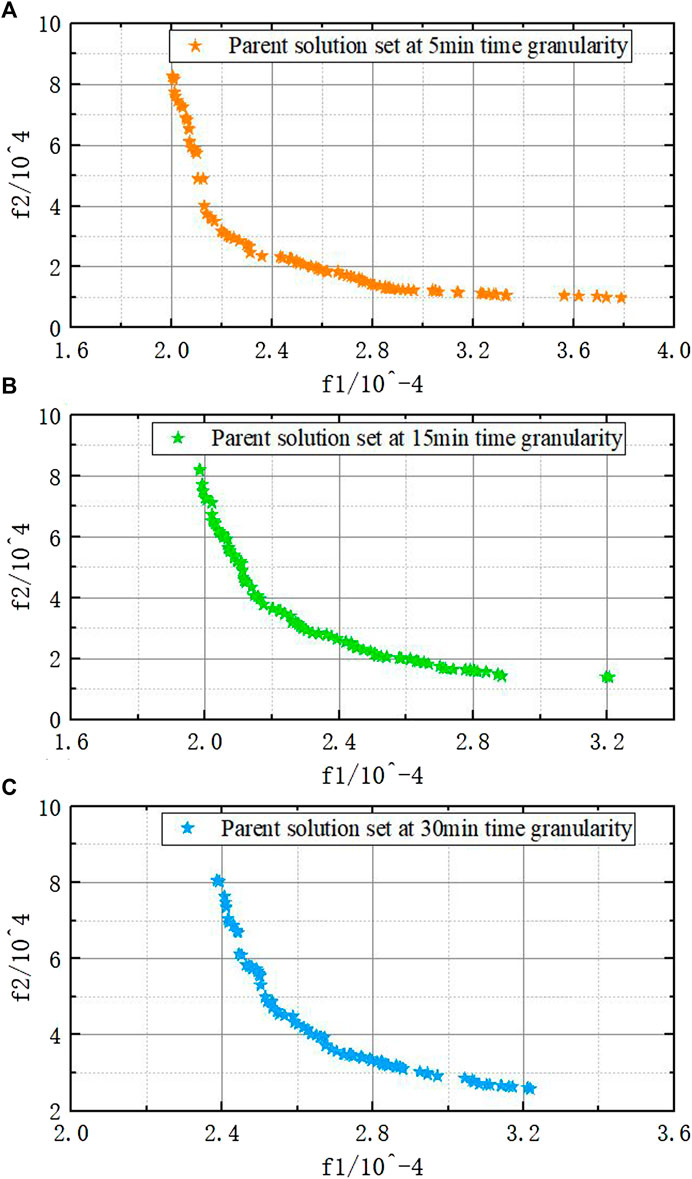
FIGURE 12. Pareto solution set under different time granularities. (A) Pareto solution set at 5 min time granularity; (B) Pareto solution set at 15 min time granularity; (C) Pareto solution set at 30 min time granularity.
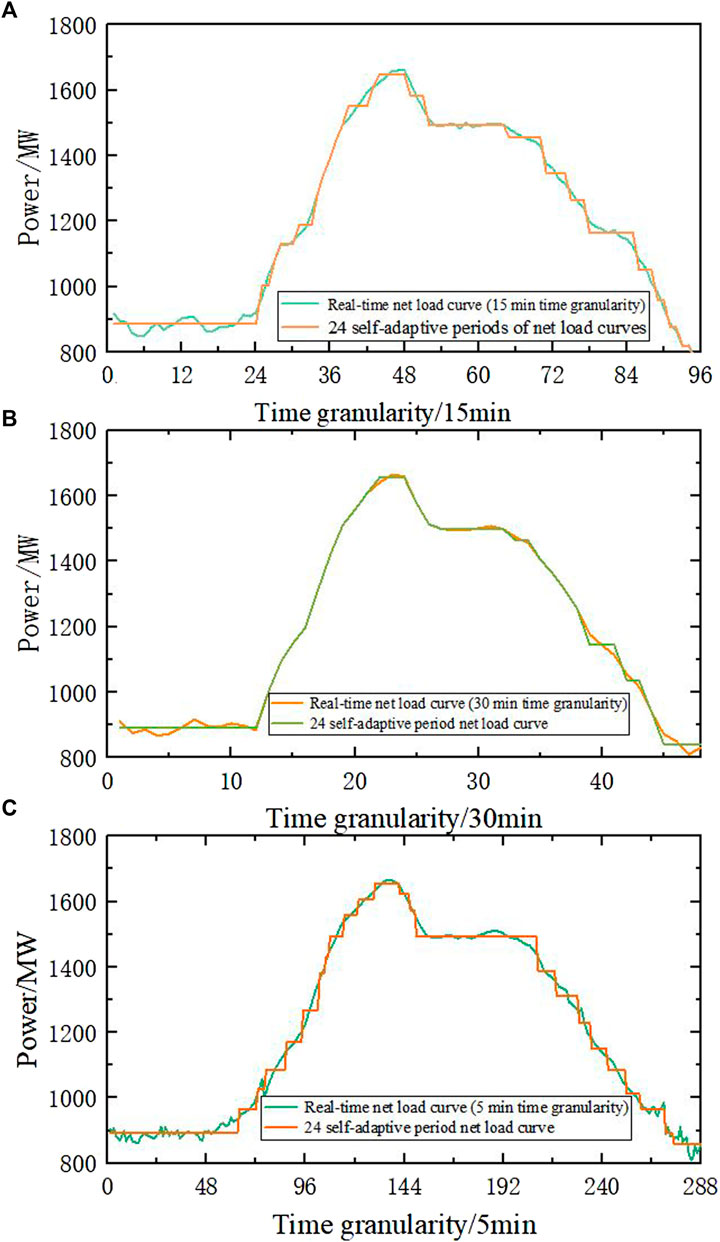
FIGURE 13. Segmentation of the net load curve under different time granularities. (A) Segmentation of net load curve at 5 min time granularity; (B) Segmentation of net load curve at 15 min time granularity; (C) Segmentation of net load curve at 30 min time granularity.
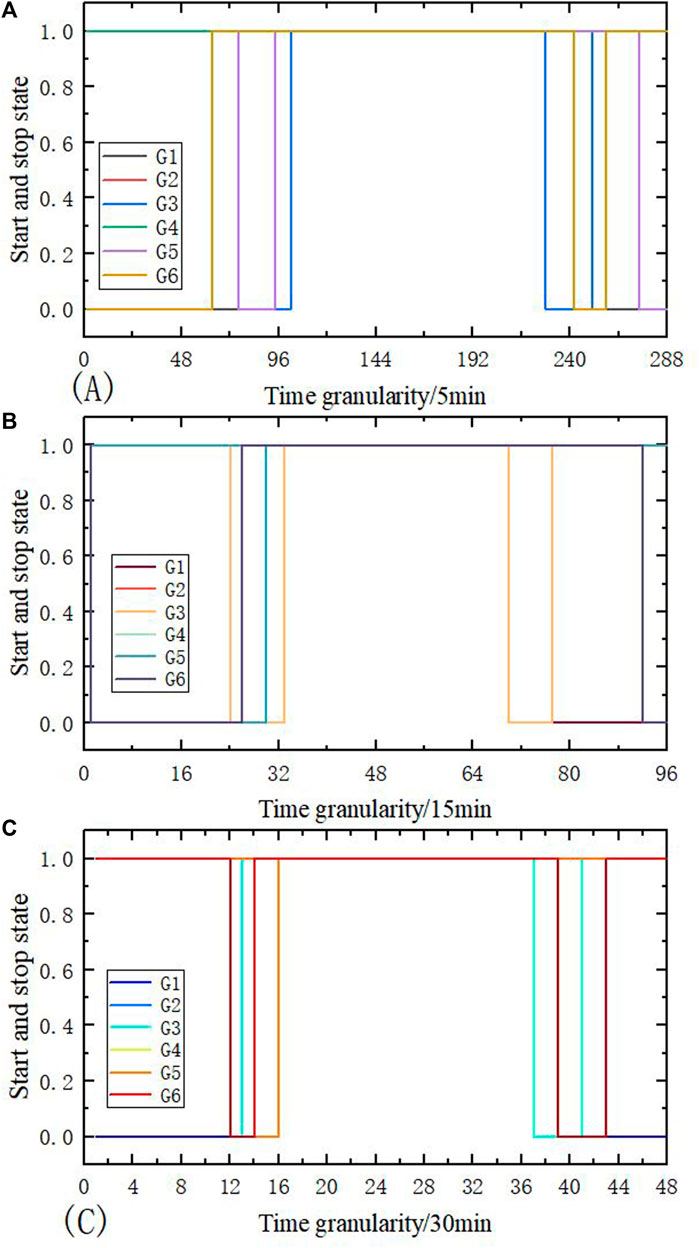
FIGURE 14. Startup and shutdown statuses of the thermal power unit under different models. (A) The start-stop state of the unit under the time granularity of 5 min; (B) The start-stop state of the unit under the time granularity of 15 min; (C) The start-stop state of the unit under the time granularity of 30 min.
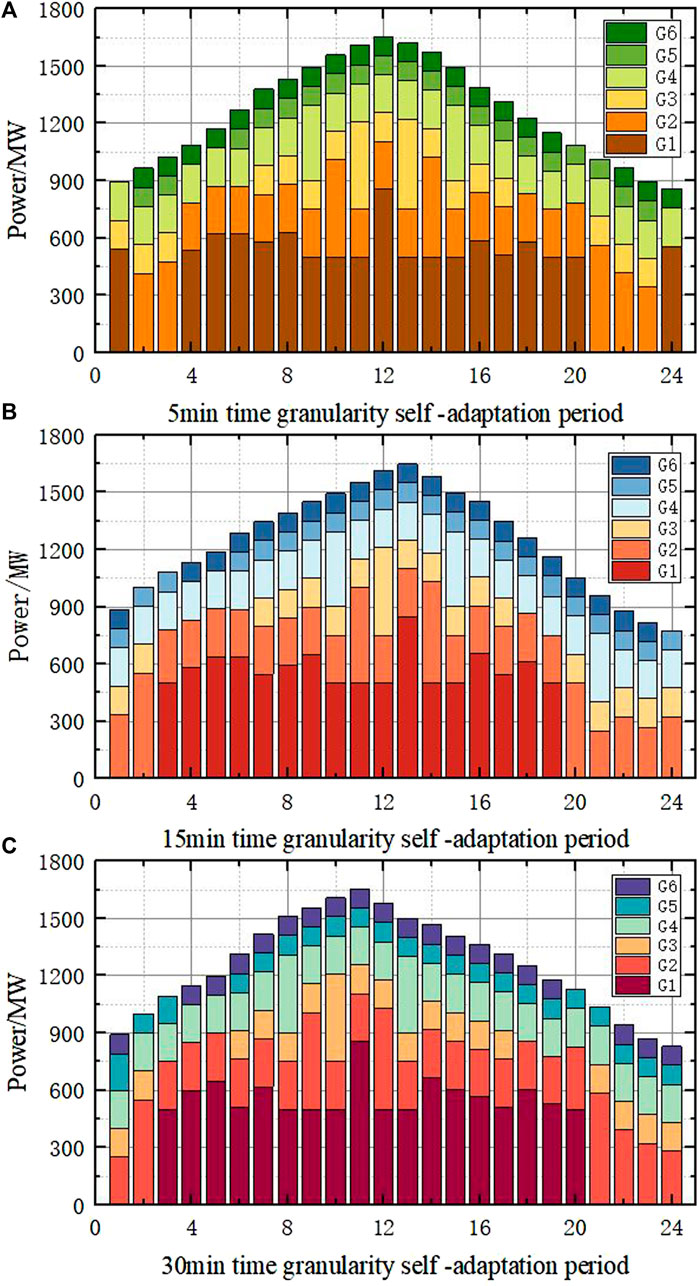
FIGURE 15. Output arrangement of the thermal power unit under different models. (A) Thermal power unit output at 5 min time granularity; (B) Thermal power unit output at 15 min time granularity; (C) Thermal power unit output at 30 min time granularity.
6 Conclusion
In this paper, the wind power grid-connected system caused by the sharp increase in peak-shaving costs and traditional scheduling is not sufficient to achieve flexible operation of the system problems; an adaptive double-layer economic dispatch model of the net load curve with reasonable exhaust air is constructed. The model makes full use of the adjustable ability of time granularity to the load gradient change and effectively responds to the net load change, while improving the wind power absorption capacity and ensuring the overall economy and environmental protection of the system. The following conclusions are obtained by the case analysis:
1) By comparing the operating results before and after the reasonable wind curtailment, the system operating cost is reduced by 7.27%, and the peak shaving cost is reduced by 6.11% compared with before wind curtailment. The calculation results show that the net load curve after the reasonable wind curtailment is relatively gentle, which can effectively avoid the deep peak shaving of the system and reduce the peak shaving cost of the system.
2) It can be seen from the analysis results that the self-adaptive subsection optimization model of the net load curve can reduce the load deviation and better deal with the random fluctuation of the net load, so that the thermal power unit has a long stable operation time and less startup and shutdown times, thus reducing the startup and shutdown costs of the unit.
3) Comparing the net load deviation and the startup and shutdown statuses of thermal power units in the dispatching cycle under different time granularities of 5 min, 15 min, 30 min, and 1h, the total operating cost of the double-layer optimal dispatching model based on 30 min time granularity is 3. 9,601 million yuan, which is 11.15% lower than that of model 4. Among them, the peak shaving cost is 535000 Yuan lower than the total consumption of wind power. The unit output arrangement is more reasonable, and the economy is better.
How to model the uncertainty of wind power and load and how to reduce curtailment using energy storage devices still need further research.
Data availability statement
The raw data supporting the conclusions of this article will be made available by the authors, without undue reservation.
Author contributions
All authors listed have made a substantial, direct, and intellectual contribution to the work and approved it for publication.
Funding
The work was supported by the Key Research and Development Plan of Shaanxi Province (2018-ZDCXL-GY-10–04), funding from the Shaanxi Province Natural Science Basic Research Program (2022JQ-534), and the National Natural Science Foundation of China Joint Fund (Key Support Project) (U1965202).
Acknowledgments
The authors would like to express their thanks to all those who have helped them over the course of researching and writing this paper. They sincerely and heartily thank and appreciate professors GZ and KZ, whose suggestions and encouragement have given them much insight into these studies. It has been a great privilege and joy to study under their guidance and supervision. Sincere gratitude also go to all the learned professors and warm-hearted teachers who have greatly helped them in their study and in life. Also, their warm gratitude goes to their friends and family who gave them much encouragement and financial support, respectively. Moreover, they wish to extend their thanks to the library and the electronic reading room for providing much useful information for the thesis.
Conflict of interest
The authors declare that the research was conducted in the absence of any commercial or financial relationships that could be construed as a potential conflict of interest.
Publisher’s note
All claims expressed in this article are solely those of the authors and do not necessarily represent those of their affiliated organizations, or those of the publisher, the editors, and the reviewers. Any product that may be evaluated in this article, or claim that may be made by its manufacturer, is not guaranteed or endorsed by the publisher.
References
Chen, G., Zhang, X., Wang, C., Zhang, Y., and Hao, S. (2021). Research on flexible control strategy of controllable large industrial loads based on multi-source data fusion of internet of things. IEEE Access 9, 117358–117377. doi:10.1109/ACCESS.2021.3105526
Chen, Z., Hu, Y., Tai, N., Tang, X., and You, G. (2020). Transmission grid expansion planning of a high proportion renewable energy power system based on flexibility and economy. Electronics 9 (6), 966. doi:10.3390/electronics9060966
Cheng, J., Yun, J., Zheng, Y., Zhang, Y., and Li, M. (2019). Equilibrium analysis of peak regulation right trading market between wind farms and thermal power plants considering deep peak regulation. Power Syst. Technol. 43 (08), 2702–2710. 10. 13335/j. 1000-3673. pst. 2019. 0517.
Dall’Anese, E., Guggilam, S. S., Simonetto, A., Chen, Y. C., and Dhople, S. V. (2018). Optimal regulation of virtual power plants. IEEE Trans. Power Syst. 33 (2), 1868–1881. 10. 1109/TPWRS. 2017. 2741920.
Deng, T., Lou, S., Xu, T., Wu, Y., and Nan, L. (2019). Optimal dispatch of power system integrated with wind power considering demand respone and deep peak regulation of thermal power units. [J].Electrical Eng. its Automation 43 (15), 34–41. (in Chinese). doi:10.7500/AEPS201806200
Dou, C., Mi, X., Ma, K., and Xu, S. (2019). Coordinated operation of multi-energy microgrid with flexible load. J. Renew. Sustain. Energy 11 (5), 54101. doi:10.1063/1.5113927
Gan, L. K., Zhang, P. F., Lee, J., Osborne, M. A., and Howey, D. A. (704). Data-driven energy management system with Gaussian process forecasting and MPC for interconnected microgrids. IEEE Trans. Sustain. Energy 12 (1), 695–704. doi:10.1109/TSTE.2020.3017224
Gan, L., Hu, Y., Chen, X., Li, G., and Yu, K. (2022). Application and outlook of prospect theory applied to bounded rational power system economic decisions. IEEE Trans. Ind. Appl. 58 (3), 3227–3237. 10. 1109/TIA. 2022. 3157572.
Guo, T., Zhu, Y., Liu, Y., Gu, C., and Liu, J. (2020). Two-stage optimal MPC for hybrid energy storage operation to enable smooth wind power integration. IET Renew. Power Gener. 14 (13), 2477–2486. doi:10.1049/iet-rpg.2019.1178
Hao, C. A., Sna, B., Yb, B., and Fu, Y. (2021). Probability distributions for wind speed volatility characteristics:A case study of Northern Norway-ScienceDirect, Energy Reports, 7, 248–255. doi:10.1016/j.egyr.2021.07.125
Li, Y., Cai, M., Zhou, J., and Li, Q., (2022). Accelerated multi-granularity reduction based on neighborhood rough sets. Applied Intelligence. , doi:10.1007/s10489-022-03371-0
Liu, K., Yang, X., Fujita, H., Liu, D., and Qian, Y. (2019). An efficient selector for multi-granularity attribute reduction. Inf. Sci. 505, 457–472. doi:10.1016/j.ins.2019.07.051
Liu, S., and Shen, J. (2022). Modeling of large-scale thermal power plants for performance prediction in deep peak shaving. Energies 15, 3171. doi:10.3390/en15093171
Liu, Y., Liu, Q., Guan, H., Li, X., Bi, D., Guo, Y., et al. (2022). Optimization strategy of configuration and scheduling for user-side energy storage. Electronics 11 (1), 120. doi:10.3390/electronics11010120
Liu, Y., Qiao, Y., Han, S., Xu, Y., Geng, T., and Ma, T. (2021). Quantitative evaluation methods of cluster wind power output volatility and source-load timing matching in regional power grid. Energies 14 (16), 5214doi. doi:10.3390/en14165214
Luo, G., Zhang, X., Liu, S., Dan, E., and Guo, Y. (2019). Demand for flexibility improvement of thermal power units and accommodation of wind power under the situation of high-proportion renewable integration—Taking north hebei as an example. Environ. Sci. Pollut. Res. 26 (7), 7033–7047. doi:10.1007/s11356-019-04177-3
Ming, D. A., Yn, A., Bo, H. B., Zhou, G., Luo, H., and Qi, X. (2021). Frequency regulation analysis of modern power systems using start-stop peak shaving and deep peak shaving under different wind power penetrations. Int. J. Electr. Power & Energy Syst. 125, 106501. doi:10.1016/j.ijepes.2020.106501
Mz, A., Zy, A., Wei, L. A., Yu, J., Dai, W., and Du, E. (2021). Enhancing economics of power systems through fast unit commitment with high time resolution. Appl. Energy 281, 116051. doi:10.1016/j.apenergy.2020.116051
Ran, L. I., Fan, S., Liu, H., Ding, X., Han, Y., and Yan, J. (2020). Economic dispatch with hybrid time-scale of user-level integrated energy system considering differences in energy characteristics. Power Syst. Technol. 44 (10), 3615–3624. 10. 13335/j. 1000-3673. pst. 2020. 0420.
Shi, H., Ma, Q., Smith, N., and Li, F. (2019). Data-driven uncertainty quantification and characterization for household energy demand across multiple time-scales. IEEE Trans. Smart Grid 10 (3), 3092–3102. 10. 1109/TSG. 2018. 2817567.
Song, T., Han, X., and Zhang, B. (2021). Multi-time-scale optimal scheduling in active distribution network with voltage stability constraints. Energies 14 (21), 7107. doi:10.3390/en14217107
Sun, Ke, MengCheng, JianLin, and Wang, Zhidong (2020). Wind fram access capacity and access location optimization method aming at minimum wind abandonment[J]. Adv. Technol. Electr. Eng. Energy 39 (08), 40–46. 10. 12067/ATEEE1905069.
Tang, Z., Liu, J., and Zeng, P. (2022). A multi-timescale operation model for hybrid energy storage system in electricity markets. Int. J. Electr. Power & Energy Syst. 138, 107907. doi:10.1016/j.ijepes.2021.107907
Verma, S., Pant, M., and Snasel, V. (2021). A comprehensive review on NSGA-II for multi-objective combinatorial optimization problems. IEEE Access 9, 57757–57791. doi:10.1109/ACCESS.2021.3070634
Wang, J., Huo, J., Zhang, S., Teng, Y., Li, L., and Han, T. (2021). Flexibility transformation decision-making evaluation of coal-fired thermal power units deep peak shaving in China. Sustainability 13 (4), 1882. doi:10.3390/su13041882
Wang, M., Wu, Y., Yang, M., Wang, M., and Jing, L. (2022). Dynamic economic dispatch considering transmission–distribution coordination and automatic regulation effect. IEEE Trans. Ind. Appl. 58 (3), 3164–3174. doi:10.1109/TIA.2022.3152455
Wanlan, Shuai, Zhu, Ziwei, Li, Xuemeng, Luo, Zhijiang, Zhu, Hailong, and Zhang, Yining (2021). Source-network-load-storage” coordinated optimization operation for an integrated energy system considering wind power consumption[J]. Power Syst. Prot. Control 49 (19), 18–26. (in Chinese). doi:10.19783/j.cnki.pspc.210037
Wei, H., Lu, Y., Yang, Y., Zhang, C., Wu, Y., Li, W., et al. (2022). Flexible operation mode of coal-fired power unit coupling with heat storage of extracted reheat steam. J. Therm. Sci. 31 (2), 436–447. doi:10.1007/s11630-022-1583-z
Yang, B., Cao, X., Cai, Z., Yang, T., Chen, D., Gao, X., et al. (2020). Unit commitment comprehensive optimal model considering the cost of wind power curtailment and deep peak regulation of thermal unit. IEEE Access 8, 71318–71325. doi:10.1109/ACCESS.2020.2983183
Yang, P., Ji, C., Li, P., Yu, L., Zhao, Z., Zhang, B., et al. (2021). Hierarchical multiple time scales cyber-physical modeling of demand-side resources in future electricity market. Int. J. Electr. Power & Energy Syst. 133 (12), 107184. doi:10.1016/j.ijepes.2021.107184
Zang, Z., Yang, X., Li, Z., Yuan, Z., Xu, C., and Chen, S. (2022). Low-carbon economic scheduling of solar thermal storage considering heat storage transformation and optimal energy abandonment[J]. Power Syst. Prot. Control 50 (12), 33–43. (in Chinese). doi:10.19783/j.cnki.pspc.211405
Keywords: wind power consumption, reasonable wind curtailment, net load curve segmentation, self-adaptation, time granularity, double-layer optimal scheduling
Citation: Gang Z, Yue Y, Tuo X, She ZK and Xin H (2023) Curve and double-layer economic dispatching considering reasonable wind abandonment under different time granularities. Front. Energy Res. 10:1057522. doi: 10.3389/fenrg.2022.1057522
Received: 29 September 2022; Accepted: 07 November 2022;
Published: 12 January 2023.
Edited by:
Mohamed Mohamed, Umm al-Qura University, Saudi ArabiaReviewed by:
Xingsi Xue, Fujian University of Technology, ChinaS. M. T. Bathaee, K.N.Toosi University of Technology, Iran
Copyright © 2023 Gang, Yue, Tuo, She and Xin. This is an open-access article distributed under the terms of the Creative Commons Attribution License (CC BY). The use, distribution or reproduction in other forums is permitted, provided the original author(s) and the copyright owner(s) are credited and that the original publication in this journal is cited, in accordance with accepted academic practice. No use, distribution or reproduction is permitted which does not comply with these terms.
*Correspondence: Zhang Gang, emhhbmdnYW5nMzQ2MzAwM0AxNjMuY29t
 Zhang Gang
Zhang Gang Yang Yue
Yang Yue